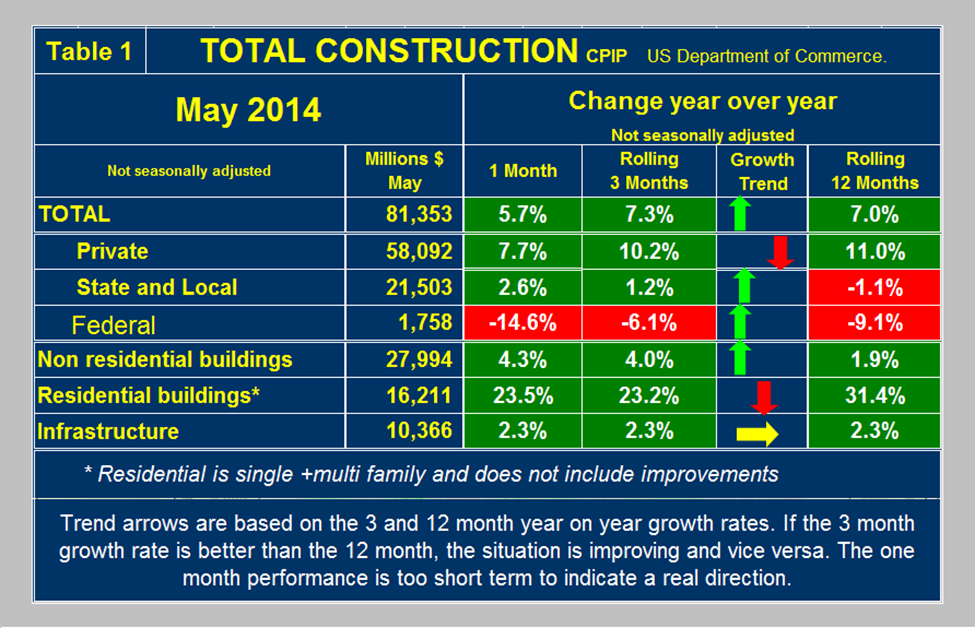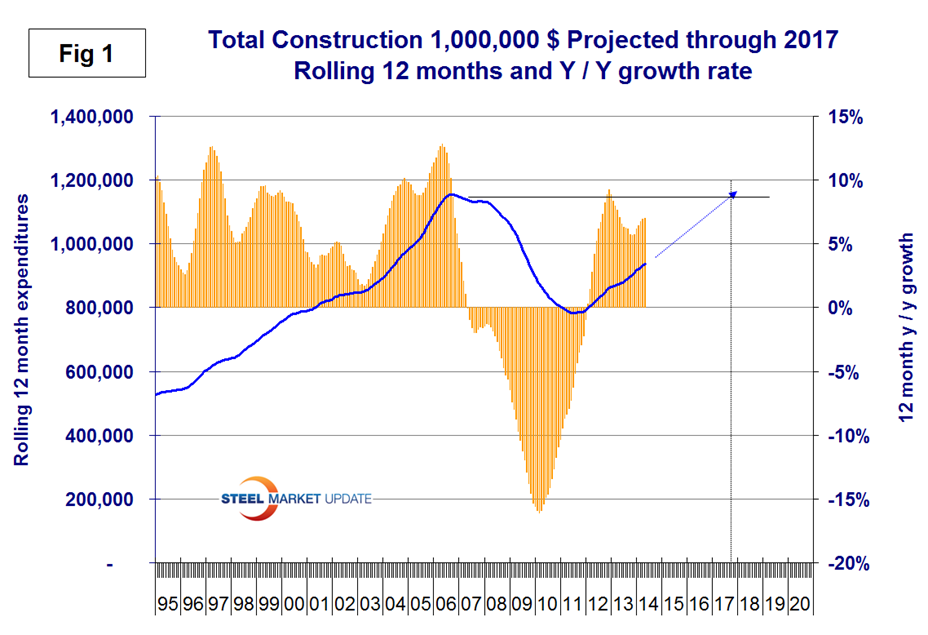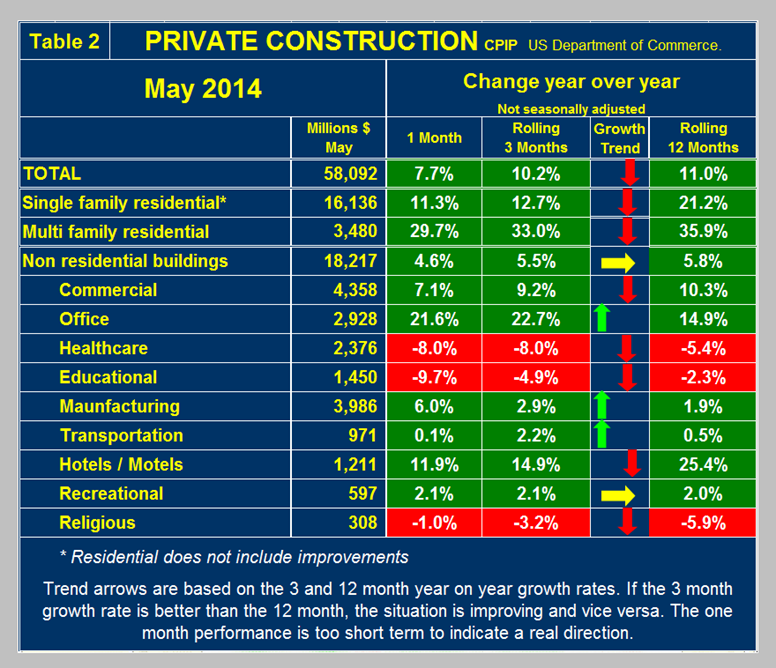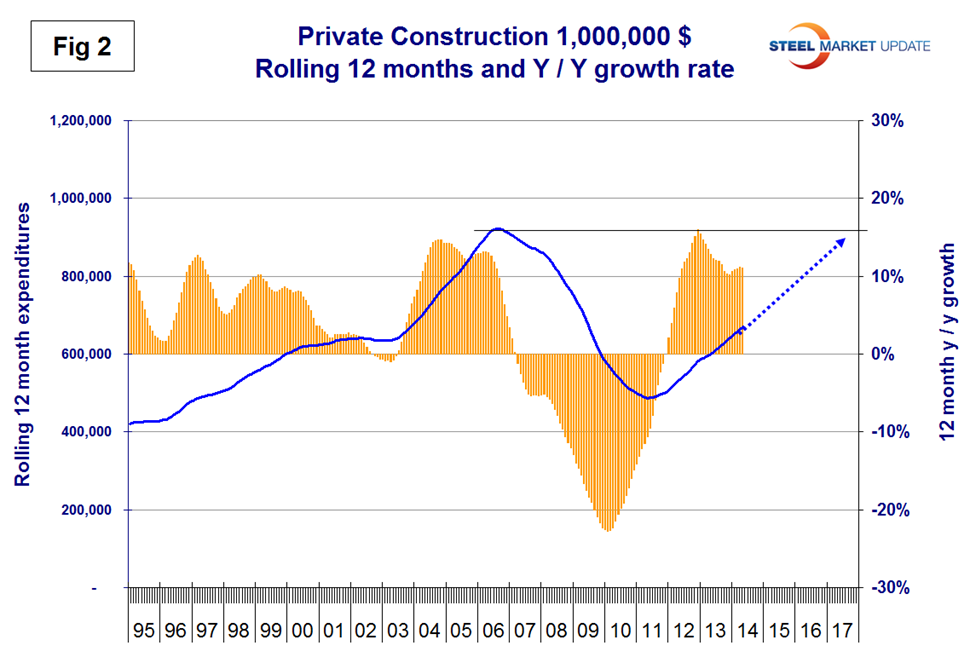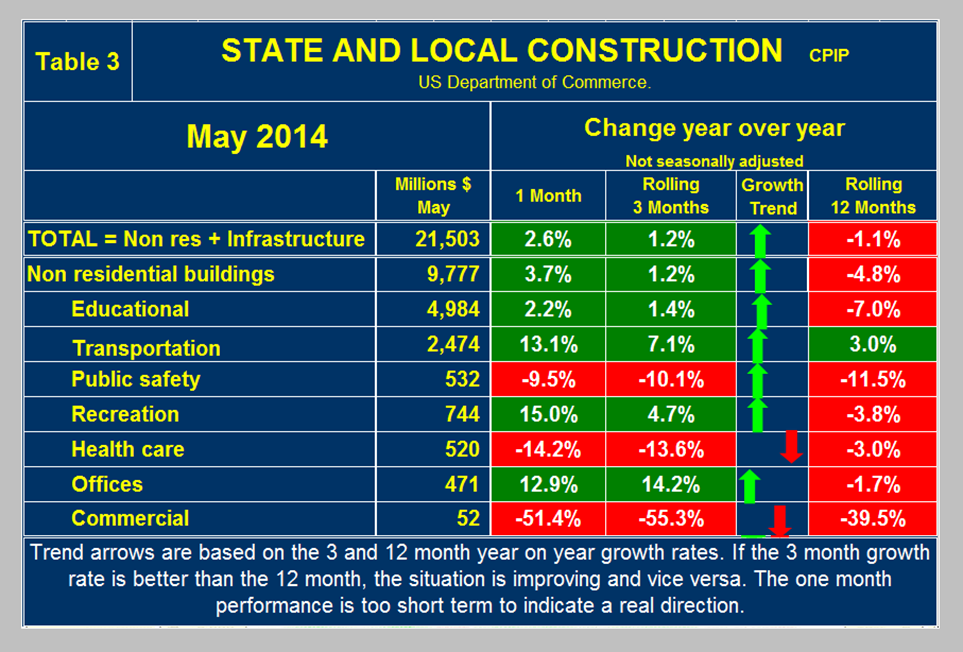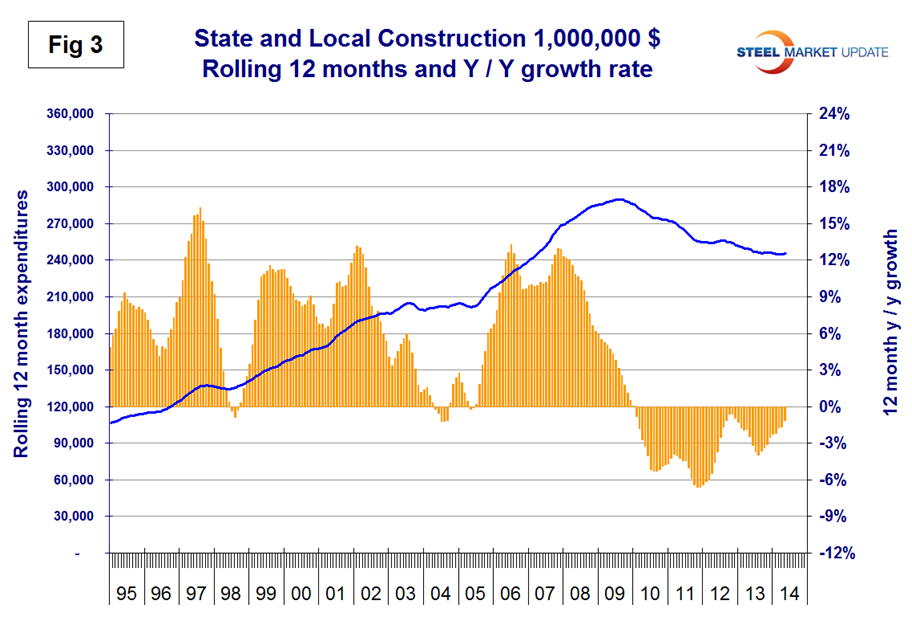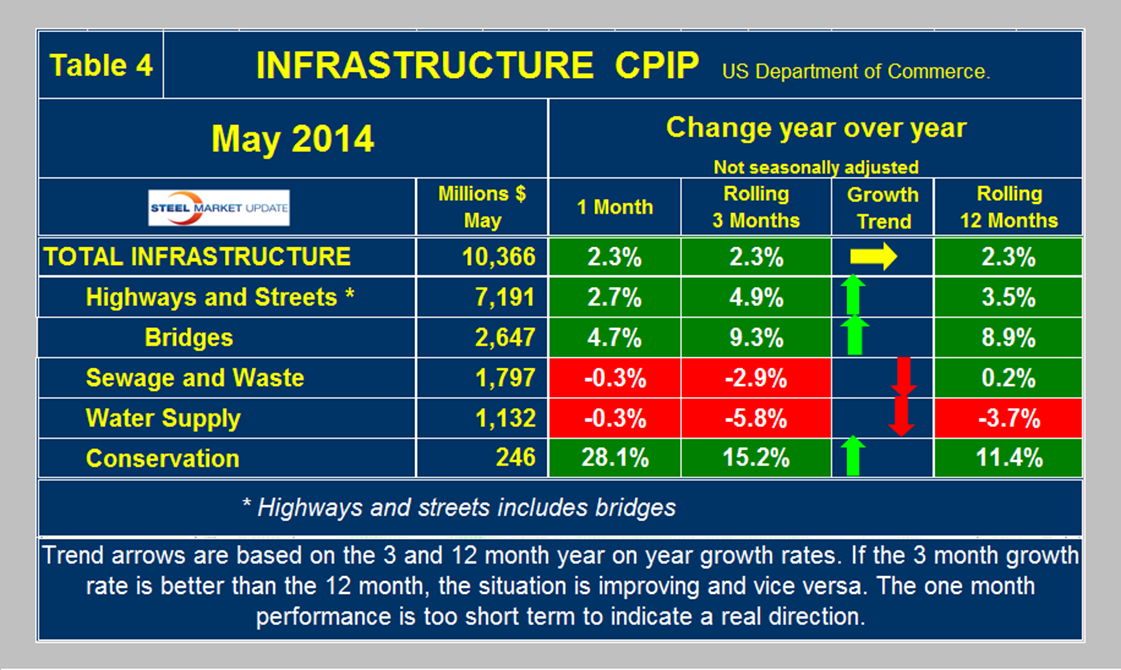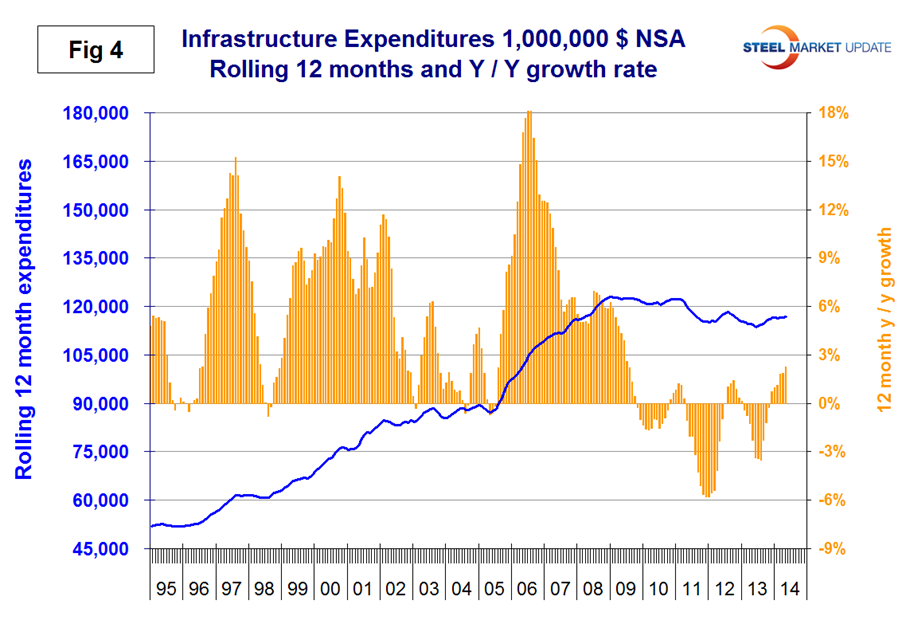Analysis

July 1, 2014
Construction Expenditures through May 2014
Written by Peter Wright
The following article is a Premium Level article written by Peter Wright:
Each month the Commerce Department issues its construction put in place (CPIP) data on the first working day covering activity two months earlier. May data was released on July 1st and all historical data was revised back to January 2008. This long term revision was upwards overall by about 1 percent.
Total Construction: Data is reported on both a seasonally adjusted and non-adjusted basis. In the SMU analysis we consider only the non-adjusted data and remove seasonality by the consideration of year over year (y/y) data. We also focus on rolling 3 and 12 months to remove the noise in single month numbers. May expenditures were $81.353 billion which breaks down to $58.092 B of private work, and $21.503 B of state and locally (S&L) funded work and $1.758 B of federally funded, (Table 1).
Federal expenditures declined 14.6 percent in May and on a rolling 12 month basis y/y were down by 9.1 percent. The Federal sector is so small as to be of little interest to us as we review the big picture. On a rolling three month basis total construction was up by 7.3 percent y/y and was up by 7.0 percent on a rolling 12 months y/y. This means that total construction growth is accelerating slightly since the short term growth (3 months) is greater than the long term, (12 months). Note this is not a seasonal effect because our y/y analysis removes seasonality. Private work has negative momentum but state and local momentum was positive in the May results. We consider three sectors within total construction. These are non-residential, residential and infrastructure. On a rolling three month basis y/y non-residential is growing at 4.0 percent and accelerating. Residential is growing at 23.2 percent and slowing. Infrastructure grew 2.3 percent y/y and was flat in the last three months compared to the rolling 12 month number. The growth of total construction has been fairly steady for over 18 months but it will be Q3 2017 before the pre recessionary peak is regained, (Figure 1). The pre-recession peak of total construction on a rolling 12 month basis was $1,145 B in 12 months through February 2007. The low point was $768 B in 12 months through May 2011. The 12 month total through the latest data of May 2014 was $938 B. This means that total construction is still only 82 percent of its pre-recession peak.
Private Construction: Private work decelerated slightly from an 11.0 percent growth rate in 12 months y/y to a 10.2 percent rate in 3 months y/y, (Table 2).
The growth of private work has exceeded 10 percent for the last 21 months but at the current rate it will be mid 2017 before recovery is complete, (Figure 2). Table 2 breaks down the private sector into project types. Residential buildings, both single and multi-family, still have strong y / y growth but are slowing. Particularly single family. This data coincides well with the housing starts data that SMU reports every month. At SMU we regard the housing situation as both critical to the economic recovery and poorly understood. It appears that a seismic shift may be underway in the population’s attitude to the roof over their heads when it comes to the buy or lease decision. Private non-residential buildings grew at a 5.5 rate in three months through May y / y with a slightly negative momentum. Within private non-residential, only health care, educational and religious buildings are showing a sustained contraction. Offices and hotels / motels continue to show surprising strength with offices acceleration and accommodation slowing.
State and Local Construction: S&L work increased by 2.6 percent in the single month of May y/y and the rolling three months also increased by 1.25, (Table 3).
Overall state and local construction expenditures on a rolling 12 month basis appear to have almost bottomed out, (Figure 3). S&L non-residential building grew by 1.2 percent in three months through May y/y which was a turnaround from the 4.8 percent contraction in 12 months y/y. Educational buildings are about 75 percent funded by state and local governments and are by far the largest sub sector of S&L non-residential at almost $5 billion in May which was the first month in two years to have positive y/y growth in the rolling three month volume. Transportation terminals continue to do well and office construction has had double digit growth in the last three months on a rolling three month basis. State fiscal balances are improving as income and sales tax revenues recover and property values / taxes increase. However, many state and local governments are far from healthy, as increased revenues have been more than offset by increased future obligations, including the need to replenish reserve and rainy-day funds and to service defined benefit liabilities, pensions foremost. Therefore, there is little room for increased public spending on all but the most essential categories. Considering the financial weakness of many sub-national governments, it will be many years before public construction catches up to pre-recession levels.
Drilling down into the private and S&L sectors, as presented in Tables 2 and 3, shows which project types should be targeted for steel sales and which should be avoided. There are some project types within S&L that are doing quite well.
Infrastructure: Expenditures have had positive growth in each of the last nine months through May with a + 2.3 percent result in the latest data. The growth in three months is the same as that in 12 months meaning that momentum is zero as the industry waits for the resolution of the highway trust fund issue. Bridge construction is still strong and accelerating which pushed highways and streets to a 4.9 percent growth in three months, (Table 4).
Water supply and sewage and waste continued to contract through May both with negative momentum. On a rolling 12 month basis, infrastructure expenditures are about where they were two years ago. (Figure 4).
The press release from the Commerce Department on Monday read as follows:
May 2014 Construction at $956.1 Billion Annual Rate
The U.S. Census Bureau of the Department of Commerce announced today that construction spending during May 2014 was estimated at a seasonally adjusted annual rate of $956.1 billion, 0.1 percent above the revised April estimate of $955.1 billion. The May figure is 6.6 percent above the May 2013 estimate of $896.6 billion. During the first 5 months of this year, construction spending amounted to $358.1 billion, 8.2 percent above the $331.1 billion for the same period in 2013.
Private Construction: Spending on private construction was at a seasonally adjusted annual rate of $682.8 billion, 0.3 percent below the revised April estimate of $684.6 billion. Residential construction was at a seasonally adjusted annual rate of $354.8 billion in May, 1.5 percent below the revised April estimate of $360.1 billion. Nonresidential construction was at a seasonally adjusted annual rate of $328.0 billion in May, 1.1 percent above the revised April estimate of $324.5 billion.
Public Construction: In May, the estimated seasonally adjusted annual rate of public construction spending was $273.3 billion, 1.0 percent above the revised April estimate of $270.5 billion. Educational construction was at a seasonally adjusted annual rate of $62.0 billion, 0.6 percent below the revised April estimate of $62.4 billion. Highway construction was at a seasonally adjusted annual rate of $82.7 billion, 0.7 percent above the revised April estimate of $82.2 billion.



